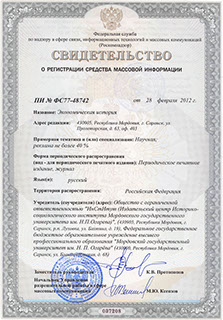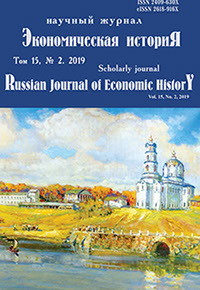Экономическая историЯ
Russian Journal of Economic History
ISSN 2409-630X (Print)
ISSN 2618-916X (Online)
Expert board:
- Scientific Council of RAS on economic history;
- Research and Educational Center «The economic history of Central Russia and the Middle Volga region» of Ogarev Mordovia State University;
- Center of Economic History of Lomonosov Moscow State University
Navigation
Certificate of registration

ISSN 2409-630X (Print), ISSN 2618-916X (Online)
DOI: 10.15507/2409-630X.045.015.201902.154-165
УДК 39(=511.152)
Elena N. Mokshina1, Mihail I. Svyatkin2
1 National Research Ogarev Mordovia State University
(Saransk, Russia), e-mail: enm2112@mail.ru
2 National Research Ogarev Mordovia State University
(Saransk, Russia), e-mail: mihail_svyatkin@mail.ru
TRADITIONAL OUTBUILDINGS OF THE MORDOVIANS
Introduction. The article deals with the main traditional outbuildings of the Mordvinians, reported on their functional purpose in economic activity. The forms and types of outbuildings, as well as the main building materials used by Mordvinians are described in details. Their significance in the religious and ceremonial life of the ethnic group is shown. Materials and Methods. The research is based on traditional methods of ethnographic science, such as field observation, survey and interviews, and a comprehensive approach. Among the methods of historical science comparative-historical, historical-genetic, problem-chronological, structural-system were used. Among the general scientific methods of research logical, descriptive, narrative, generalization, classification and systematization were involved. To achieve the results of the study, the materials collected by the authors in the course of field surveys conducted in the Mordovian villages were mainly used. Results and Discussion. Traditional outbuildings were of great importance in the economic activity of the Mordovian ethnic group. According to their functional purpose, they can be divided into the following groups: for livestock and poultry (stable, chicken coop, stable, kalda), sanitary and hygienic (bath), warehouse buildings for storage of food, utensils, firewood, animal feed (barn, cellar, woodshed, hayloft), for processing of grain (sheep, riga, mill). Depending on the welfare and financial capacity of the family, the number of outbuildings was different. As a rule, the wealthier families had more outbuildings than the less wealthier ones. The main building material for the construction of these buildings was wood. Conclusion. Thus, the traditional outbuildings of the Mordvinians occupied an important place in its economic activities. At the same time, each of them had its own purpose and performed certain functions. Some buildings, such as a bath and a barn, had not only economic purpose, but also were the venue for a number of prayers and ceremonies. It is now ordinarily they have banya (bath-house), outdoor courtyard with standing in different places sheds, barn and cellar.
Keywords: economy, Mordvins, material culture, life, traditions, rites, prayers, outbuildings, barn, barn, cellar, barn, mill, bath, yard.
For citation: Mokshina E. N., Svyatkin M. I Traditional Outbuildings of the Mordovians. Ekonomicheskaya istoriya = Russian Journal of Economic History. 2019; 15(2): 154–165. (In Russ.). DOI: 10.15507/2409-630X.045.015.201902.154-165.
© Ogarev Mordovia State University. History and Sociology Institute, 2017
68, Of. 411, Bolshevistskaya St., 430005, The editorial office of the scholarly journal «Russian Journal of Economic History»
Tel.: (8342) 24-25-90; 27-07-11, Fax: (8342) 24-25-90, E-mail: jurnal-econom-hist@isi.mrsu.ru
Designed by A. Napalkov, Email: napalkov@isi.mrsu.ru

